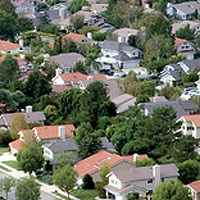
‘You can fit two Barcelonas with four million inhabitants each into a Perth template…’
So mentioned Charles Landry on his visit to Perth earlier this year as ‘Thinker in Residence’ for FORM.
Following the recent debates on the future of the City of Perth, it’s worth discussing some of the history behind the development of Australian cities and our apparent love of the sprawling metropolis. Suburbia is a place idealised within the Australian psyche. Inherently tied to the ‘Great Australian Dream’ of owning one’s own home, suburbia is a place where anyone can make it happen: that ‘it’, usually involving a patch of grass, 2.5 kids, and perhaps, a small investment in Telstra-2.
Reflecting on his travels through the metro area, Mr Landry stated that while he did not ‘denigrate the delights of suburbia… Perth has 98% of it’. Though we often take it for granted, the suburb is a relatively recent creation in modern cities that has its origins in the ever-expanding outer districts of 18th century London.
Bourgeois Utopia
The modern suburb is a direct result of the unprecedented growth of London in the 18th century when immense wealth was flowing into the city from the colonies. At the time, home and work were inseperable, and even the wealthy merchant bankers in the centre of the city conducted business from home with the help of their families.
As advances such as the train system made the outer areas closer, the dirty, noisy, and crime-filled city became something to escape from at the end of the day. In a trend that is reversing across Australia and internationally, wealthy people gravitated to the outskirts in search of space. The suburbs simulated a pastoral culture that idealised wide-open spaces.
Living beyond the city became a status symbol, as commuters would often have the luxury of their own coach to get them to and from work. The suburbs, therefore, began to separate people by class; whereas in the city, members of different classes would live on the same streets and in the same neighbourhoods as each other.
At the same time, the model of the ‘nuclear family’ – a product of the Evangelical movement, which was gaining momentum towards the end of the 1800s –began to take hold in the English psyche. In a philosophy that most Western women would spit at today, Evangelicals felt that the ‘special role’ of women as nurturers had to be separated from the business and social worlds of the city – resulting in the stay-at-home housewife.
Current advertising for developments in Perth still bears the mark of this ideology and includes catchphrases such as ‘natural family haven’, ‘serenity and convenience’, and ‘tranquil parklands’, while of course being ‘close to the CBD’.
Playing on the sensibilities of ‘the home’, ‘the nuclear family’, and an idealistic notion of what a ‘good’ English home should be, the early suburbs were feminised spaces that served to separate the masculine, raw, debauched life of the cities from wholesome home life. It is little wonder that, failing to identify with this concept, a large proportion of the queer population gravitated inwards to the inner-city districts.
The Australian Dream?
In the Australian experience, the rural, pioneering bush spirit is an idealised concept far removed from the lives of most people. The suburb was therefore a natural medium between a longing for space and a need for the conveniences of the city.
Between World War II and the 1960s, 70% of Australians came to own their own homes. This was due in part to a migrant desire for security following the hardship endured in their homelands and a need to set-up in a new country. In Australia, the growth of the suburbs from the 40s onwards was about creating a new life.
Australians have a unique relationship with the outdoors; this strong sense of space means that the Australian version of suburbia is quite different from the English or the American expressions. We have larger block sizes than other countries, with the ‘quarter acre’ being the norm of past generations. However, in a climate of rising house prices, this is no longer an option. Perhaps, the new Australian dream should be to purchase a home for under $300,000?
Entertaining Suburbia
Suburbia in Australia has been both criticised and idealised for its middle-class mentality, the ordinariness of its architecture, and its kitsch cultural taste.
In the 1970s, Dame Edna became an international symbol of the Australian suburban housewife. This played on some of the fears associated with living in suburbia – irrelevance, lack of style, a cultural vacuum, and so on. The suburbs were both a place of freedom (due to home ownership) and a claustrophobic space that many felt the need to ‘escape’ from. In the 2000s, Kath and Kim arrived to entertain the next generation by showing us suburban Australians everything we hate and love about ourselves.
The Dream is Over?
Australia’s suburbia has firmly placed its stamp on the nation psyche – what other nation would place the Victa lawnmower and the Hills Hoist on a pedestal? However, the high environmental and economic cost of providing infrastructure to service the coastal sprawl means that the ubiquitous low density housing of the ‘burbs could become untenable in the future.
Is Australia ready to replace the idyll that is suburbia with the higher density living we as a society can afford? This challenge of redefining our lifestyle is one that will no doubt require massive change in our cultural and social fabric and a reconceptualisation, for many, of what it means to live the Australian Dream.
As for our new urban icons? Well, thanks to the globalised economy, there’s a certain Swedish furniture store that are so adept at storage gadgets for almost everything that surely we can find something that will mow the carpet, dry the washing and stash a couple of Barcelonas in the closets of an inner city eco-villa .





